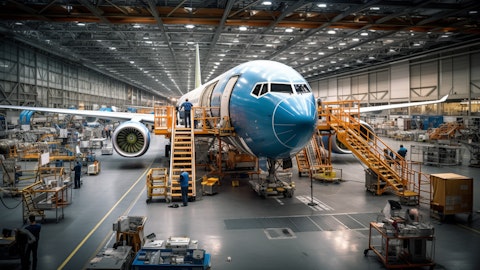Delta Air Lines, Inc. (NYSE:DAL) Q1 2024 Earnings Call Transcript April 10, 2024
Delta Air Lines, Inc. beats earnings expectations. Reported EPS is $0.45, expectations were $0.36. DAL isn’t one of the 30 most popular stocks among hedge funds at the end of the third quarter (see the details here).
Operator: Good morning, everyone, and welcome to the Delta Air Lines March Quarter 2024 Financial Results Conference Call. My name is Matthew, and I’ll be your coordinator. At this time, all participants are in a listen-only mode until we conduct a question-and-answer session following the presentation. As a reminder, today’s call is being recorded. [Operator Instructions] I would now like to turn the conference over to Julie Stewart, Vice President of Investor Relations. Please go ahead.
Julie Stewart: Thank you, Matthew. Good morning, everyone, and thanks for joining us for our March quarter 2024 earnings call. Joining us from Atlanta today are: CEO, Ed Bastian; our President, Glen Hauenstein; and our CFO, Dan Janki. Ed will open the call with an overview of Delta’s performance and strategy, and Glen will provide an update on the revenue environment, Dan will discuss costs and our balance sheet. After the prepared remarks, we’ll take analyst questions. We ask you to please limit yourself to one question and a brief follow-up, so we can get to as many of you as possible. And after the analyst Q&A, we’ll move to our media questions. Today’s discussion contains forward-looking statements that represent our beliefs or expectations about future events.
All forward-looking statements involve risks and uncertainties that could cause the actual results to differ materially from the forward-looking statements. Some of the factors that may cause such differences are described in Delta’s SEC filings. We’ll also discuss non-GAAP financial measures, and all results exclude special items, unless otherwise noted. You can find a reconciliation of our non-GAAP measures on the Investor Relations page at ir.delta.com. And with that, I’ll turn the call over to Ed.
Ed Bastian: Well, thank you, Julie, and good morning, everyone. We appreciate you joining us today. Earlier this morning, we reported our March quarter results posting pre-tax earnings of $380 million or $0.45 per share, a $0.20 improvement over last year, and revenue that was 6% higher and a new record for first quarter. Free cash flow was $1.4 billion and we delivered a return on invested capital of nearly 14%, putting Delta’s returns in the top half of the S&P 500. We are delivering industry-leading operational reliability and have widened the gap to our competition. Last summer, we made forward-leaning investments in the operation. And since then, our teams have delivered operational performance that is among the best in our history, with mainline cancellations down 85%, setting new records for completion factor in both the fourth quarter and the first quarter.
I’d like to sincerely thank Delta’s 100,000 people for your dedication, professionalism, and hard work in delivering these outstanding results. In February, we recognized the efforts of our people with $1.4 billion in profit-sharing, more than the rest of the industry combined, and continuing Delta’s longstanding philosophy to reward industry-leading performance with industry-leading compensation. Reflecting our people-first culture, Forbes ranked Delta the fifth-best large employer in America, and Delta was recently named the 2024 Global Airline of the Year by Air Transport World for our outstanding commitment to safety, operational performance, and premium customer service. While airline travel and transportation is what we do, it’s the experiences on Delta that set us apart as a leading consumer brand and why Delta was recognized as number 11 on Fortune’s list of the World’s Most Admired Companies.
Exciting customer-facing enhancements are on the near horizon, including the opening of new Delta One lounges in JFK, Los Angeles, and Boston, the continued introduction of modern and fuel-efficient aircraft, new premium cabin service offerings, upgrades to the Fly Delta app, and the international expansion of fast free Wi-Fi across our fleet. The rollout of Wi-Fi and Delta Sync continues to be a tremendous success. Since launching last year, customers have logged more than 45 million free streaming quality sessions on-board and millions have joined the SkyMiles program through this channel. Recognizing our investment to ensure the future of travel is connected, we took the number two spot in the travel category, a Fast Company’s list of the Most Innovative Companies, the only airline to be recognized in the ranking.
Loyalty to our brand has never been stronger. We continue to set new records with our remuneration from American Express, our most important commercial relationship and are well on our way to our long-term target of $10 billion. On February the 1, we announced enhanced and refreshed benefits for our Delta Sky Miles American Express Cards, providing more direct value and the customer response has been very positive. Turning to our outlook. With strong first-quarter performance and visibility into the strength of summer travel demand, we remain confident in our full year guidance for earnings of $6 — $6 to $7 per share, free-cash-flow of $3 billion to $4 billion, and leverage of 2.5 times, the three main guideposts that we shared with you in January.
For the June quarter, we expect to deliver the highest quarterly revenue in our history of mid-teens operating margin and earnings of $2.20 to $2.50 per share. Our forecast for pre-tax profit of approximately $2 billion is on par with 2019 and just shy of last year, due to higher fuel prices. Demand continues to be strong and we see a record spring and summer travel season with our 11 highest sales days in our history, all occurring this calendar year. Spending on services recently surpassed goods for the first time in five years and there is further runway to return to their long-term trends. Delta’s core consumers are in a healthy position and travel remains a top purchase priority. Generational shifts and evolving consumer preferences are driving secular growth in premium experiences.
And business travel demand has taken another meaningful step forward this year with growth accelerating into the mid-teens over last year. When you put this level of demand strength together with the industry’s increased focus on improving financial returns, this may be the most constructive backdrop that I’ve seen in my airline career. Our industry-leading performance continues to demonstrate the strength of Delta’s differentiated brand and returns-focused strategy. And with our disciplined approach to capital investment and focus on free cash flow, Delta is exceptionally well-positioned to further strengthen our balance sheet and deliver significant shareholder value. In closing, the momentum in the business continues to build. We are focused on delivering excellent reliability, elevating the customer experience, and improving efficiency across the Company to support growth in our earnings and cash flow.
I am excited for Delta’s opportunities ahead, and we’ll talk more about that and provide new long-term financial targets at our Investor Day, which we are scheduling for November 19 and 20 in New York City. Please put that on your calendar. Thank you again. And with that, let me hand it over to Glen for more details on our commercial performance.
Glen Hauenstein: Thank you, Ed, and good morning. I want to start by thanking our employees for providing the best service and reliability in the industry to our customers every single day. 2024 is off to a great start and we’re delivering on our commercial priorities to optimize our network, grow higher-margin revenue streams, and invest in our future. Revenue for the March quarter increased 6% year-over-year to a record $12.6 billion on capacity growth of 6.8%. This result is at the high-end of our initial guidance with upside driven by industry-leading operational performance and strength in close-in bookings. Since the start of the year, we’ve seen a sustained acceleration in business travel. Managed corporate travel sales grew 14% over the prior year, with Technology, Consumer Services and Financial Services leading that momentum.

We delivered positive unit revenues in our two largest entities, domestic and transatlantic, reflecting the continued optimization of our network. Total unit revenue growth improved 3 points sequentially to down 0.7%, including nearly a one-point headwind from cargo and MRO. Domestic revenue grew 5% with record March quarter unit revenues, up 3% over the prior year. The more than 7 point improvement from 4Q to 1Q reflects strong demand trends improving industry backdrop. International revenues grew 12% on a unit revenue decline of 3% as unit revenue growth in the transatlantic was muted by capacity investments from the continued rebuild of our Latin and Pacific franchises. Diverse high-margin revenue streams generated 57% of total revenue, differentiating Delta and underpinning industry-leading financial performance.
Premium revenue was up 10% over prior year, and we have runway ahead as we continue adding more premium seats to our aircraft, improving our retailing capabilities, and further segmenting our products. Total loyalty revenue grew 12% on continued strength in the American Express co-brand portfolio with record quarterly remuneration of $1.7 billion. Following the refreshed co-brand benefits, we saw our card applications reach new records as we are seeing the highest premium acquisitions mix in our program’s history. Turning to our outlook, consumer demand is robust and premium trends remain strong. The outlook for corporate travel is positive. 90% of companies in our recent survey intend to maintain or increase travel volumes in 2Q, putting us back on track to deliver record corporate revenues in the back half of this year.
For the June quarter, we expect revenue growth of 5% to 7% on capacity growth of 6% to 7%, with unit revenues flat to down 2% from last year’s very strong performance. Similar to the March quarter, 2Q faces a headwind from the normalization of travel credits. Domestically, we expect unit revenues to be flattish over the prior year, with growth focused on restoring our core hubs where departures and seats are not yet fully restored. The final stage of our core hub restoration will be the full return of regional flying. Pilot hiring has stabilized, increasing the capacity we expect to fly over the summer. We expect progressive improvement through 2025, driving higher asset utilization and improving our profitability. In the transatlantic, we are looking forward to another strong summer with record revenues.
2Q unit revenues are expected to be similar to the last year as we lock record performance and benefit from the healthy demand for our premium cabins and improved corporate trends. In Latin America, profitability remains solid. Unit revenues are expected to be down double-digits due to pressure in shortfall leisure markets. These markets are expected to see healthy improvements in the second-half of the year as supply and demand comes back into balance. And while flying into deep South America, we are very pleased with the results. We are increasing capacity about 40% with minimal impact to unit revenues as we continue to deepen our ties with our JV partner LATAM. We expect Pacific unit revenues to be in line with the prior year on 30% growth in capacity, driven by a strong demand for Korea and Japan, offsetting lower unit revenues in China.
Profitability is expected to set a record as we continue to harvest the benefits of our multi-year restructuring. In closing, I’m pleased with how we have started 2024. Delta is continuing to lead on all fronts, with industry-leading margins and returns highlighting the strength of our trusted brand and differentiated commercial strategy. And with that, I’d like to turn it over to Dan to talk about the financials.
Dan Janki: Great. Thank you, Glen, and good morning to everyone. For the March quarter, we delivered pre-tax income of $380 million, an improvement of $163 million over last year. Earnings of $0.45 per share was at the upper end of our guidance as great operational performance and strong demand more than offset higher-than-expected fuel prices. Operational excellence is central to Delta’s brand promise, and I couldn’t be prouder of how our teams are delivering record reliability for our customers. A strong completion factor drove a 1 point of higher capacity and non-fuel unit cost favorability. Non-fuel CASM was 1.5% above last year and ahead of guidance. Fuel prices averaged $2.76 per gallon, $0.16 higher than the midpoint of our guidance range.
The refinery provided a $0.05 benefit, generating a profit of $49 million. This was down $173 million from last year on more normalized refining margins. Fuel efficiency was 1.9% better than last year, benefiting from the continued renewal of our fleet and running a strong operation. Operating margin of 5.1% was a 0.5 point higher year-over-year. Our pre-tax margin improved over a point, benefiting from reduced interest, pension expense, and higher earnings from our equity investments. We generated free cash flow of $1.4 billion. This was after paying $1.4 billion in profit-sharing to our employees and investing $1.1 billion into the business. Debt reduction remains a top priority. Our leverage ratio improved to 2.9 times during the quarter.
We repaid $700 million of debt, including $400 million of scheduled maturities and $300 million of additional debt initiatives. We expect to repay at least $4 billion of debt this year and continue to be opportunistic in accelerating debt reduction. We are currently investment-grade rated at Moody’s and BB+ at both S&P and Fitch, with all agencies now on positive outlook following updates from Fitch and Moody’s during the quarter. Moving to the June quarter guidance. Combined with our outlook for top-line growth, we expect an operating margin of 14% to 15% with earnings of $2.20 to $2.50 per share. Fuel prices are expected to be $2.70 to $2.90 per gallon, including a $0.10 contribution from the refinery. At the midpoint of this range, our all-in fuel price is expected to be over 10% higher than last year.
Non-fuel unit costs are expected to be approximately 2% higher than last year, consistent with our full-year outlook of low-single-digit. Growth is normalizing, and we’ve entered a period of optimization with a focus on restoring our most profitable core hubs and delivering efficiency gains across the enterprise. The investments we made in fleet health and reliability in the second-half of 2023 are paying off, supporting industry-leading operational performance. As we discussed with you in January, these investments are expected to continue through 2024 as we complete an elevated volume of heavy airframe and engine checks, while managing through industry-wide supply chain constraints. The intensity of hiring and training has moderated. The teams have good momentum in delivering on our efficiency goals for the year.
This will help fund the investment in our people, in our operations, and the customer experience that support our revenue premium. In closing, we continue to be confident in our full-year outlook of earnings of $6 to $7 per share and free cash flow of $3 billion to $4 billion. Our industry-leading operational and financial performance is a result of the hard work and dedication of the Delta people. I’d like to thank each of them for what they do every day. With that, I’ll turn it back to Julie for Q&A.
Julie Stewart: Thanks, Dan. Matthew, can you please remind the analysts how to queue up for questions and go to our first analyst question from Duane Pfennigwerth.
See also 10 Underperforming Stocks Insiders are Buying and 16 Best Materials Stocks To Buy in 2024.
Q&A Session
Follow Delta Air Lines Inc. (NYSE:DAL)
Follow Delta Air Lines Inc. (NYSE:DAL)
Operator: Certainly. And at this time, we’ll be conducting a question-and-answer session. [Operator Instructions] Your first question is coming from Duane Pfennigwerth from Evercore ISI. Your line is live.
Duane Pfennigwerth: Hey, good morning. Thank you. Just on the improved cost execution, you just touched on it in the script there, Dan, but can you speak to maintenance expense and the outlook relative to your expectations? The tone sounds like you’re turning a corner on maintenance, and how do you think about that line into the second-half and perhaps into next year?
Dan Janki: Well, maintenance is — Duane, thank you. Maintenance is on plan and performing as we expected. As we talked to you at the beginning part of the year, maintenance we expect it to be up year-over-year $350 million. We expect that for the full-year, the first quarter was on plan, and the team is executing well. And those investments, as I mentioned, that we made in fleet health will continue as we go through this year, those proactive visits along touching the aircraft. You’re seeing the impact. Cancellations from a maintenance perspective year-over-year were down 80% sequentially, they improved 30%. So team is doing a good job. They’re on plan and as expected.
Ed Bastian: Duane, if I could add on to that, I want to congratulate the Tech Ops team, John Laughter, whose leadership over there in terms of helping to make that turn. We are seeing a renewed set of confidence back in the team. It’s been a tough few years on the rebuild. Too early to declare victory. We know the supply chain continues to have a tremendous amount of constraint in it. But I’m confident that we’re on a good journey. It’s a good path here.
Duane Pfennigwerth: Appreciate those thoughts. And then maybe more of a conceptual one for my follow-up on corporate and the continued recovery in corporate you’re pointing to. I assume that’s generally close in. And I wonder if you could comment on if you’re seeing a decrease in average trip length. So maybe more trips but fewer days on the road per trip. Any commentary on those trends?
Glen Hauenstein: No, I’d just say we’re seeing both. We’re seeing some shorter and we’re seeing some longer where people are blending the leisure trip with the business trip. So — and generally, they are purchasing a little bit further out than they had and I think that’s related to not having change fees any longer. So, we’ve seen some changes in the booking curve but really encouraged by what we see in terms of corporate bookings as we look forward through this quarter and as we look forward into the next couple of quarters.
Duane Pfennigwerth: Thank you very much.
Operator: Thank you. Your next question is coming from Mike Linenberg from Deutsche Bank. Your line is live.
Mike Linenberg: Oh, yes. Hey, good morning, everyone. Glen, I just — I want to get back — you talked about the normalization of travel credits and how that still represents a bit of a headwind. What — can you quantify what that impact is on June TRASM?
Glen Hauenstein: I think we said in our previous that we faced headwinds in up to a couple of points. And I think we’re not going to go into the details of that, but that’s generally what we’ve disclosed in the past. Yes.
Mike Linenberg: Okay, great. And then just my second question to Ed. Ed, can you just give us an update on the status of the — I guess it’s an appeal process with the DOT on Aeromexico? How does that play out or I should say, what is the timeline of that and any milestones we should look forward with respect to that? Thanks.
Peter Carter: Hey, Mike, it’s Peter Carter. Thanks for the question. That was a tentative order. And I think, as you know, our strong view is, the DOT really struck out on that one. They’re typically a great partner. But this was an example of regulatory overreach, which is why we’ve challenged it. It’s bad for consumers. It’s bad for competition. It’s bad for the local economies that those flights have served. We are currently engaged with the administration and discussing, I’ll say, less punitive solutions than the tentative order that was proposed. And I would say, we’ve had hundreds of our, I’ll say, allies with respect to the connection between Mexico and America weigh in, in support of this joint venture. So, we think this is going to take some time before the DOT issues a final order, a number of months, but we’re cautiously optimistic that they are going to come up with a better solution.
Mike Linenberg: Great. Thanks for that, Peter. Thank you.
Operator: Thank you. Your next question is coming from Scott Group from Wolfe Research. Your line is live.
Scott Group: Hey, thanks. Good morning. So, Glen, when I think about the original guide for the year or three months ago, I think it was sort of flat RASM for the year. So, we’re down slightly in Q1, midpoint of guide for Q2 down slightly. So, what’s the — what’s your visibility to second half RASM inflection? I guess ultimately, at this point, do you see more upside or downside risk to that flat RASM? And maybe just with that like the travel credit headwind, is that bigger or smaller in second-half?
Glen Hauenstein: No, I think it’s pretty — first on the travel credit headwinds, it’s consistent through the year. But what I would say is that we’re ahead of our internal plan to get to flattish for the year and the comps get easier as we move through the year. And if you look at the back half of guidance as well as what people have loaded in their schedules, it looks like industry capacity is reaching a peak in 2Q. So, I think we see a great setup for the back half of this year and we’re on plan or ahead of plan for where we sit right now.




